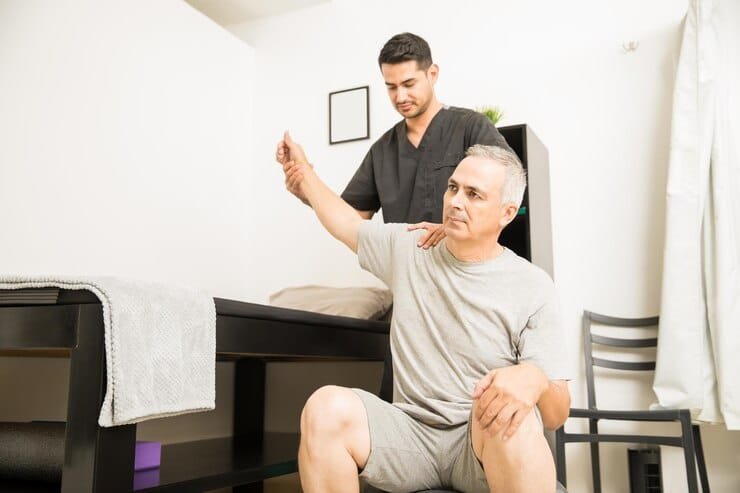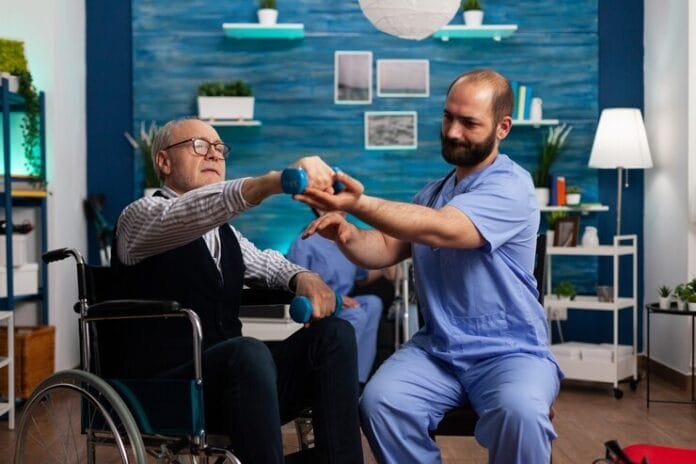Overview: Unveiling Physical Therapy’s Pivotal Role in Home Healthcare
Rehabilitation Services Role — Past, Present and Future
Whereas some novel, innovative technologies have streamlined healthcare processes, the more prevalent demand for cost-effective, patient-centered interventions have driven a paradigm shift towards home-based care delivery in the modern healthcare milieu. In this ever-evolving landscape, physical therapy (PT) occupies a pivotal position as cementing a robust rehabilitative arsenal that fuses personalization with rigor, aiming to reclaim functional capacity, alleviate pain, and enhance mobility. However, this evolution requires a paradigm shift in how we perceive PT’s contribution to home health, evolving from the existing perception of its role as an ancillary service to understanding PT as a key driver of clinical and economic value. Here, we provide an overview, establishing context for a deep dive into both the clinical and operational opportunities of maximizing PT strategic integration across home healthcare.
The Importance of Quality PT In Home Health Care
PT or physiotherapy is significant in home healthcare most because it can treat a large range of function-limiting conditions that occur throughout individuals’ lives, from post surgical treatment to chronic disease management and neurologic deficits to geriatric frailty. Patients discharged into home environments from acute care settings frequently have a need for continued therapeutic intervention to restore or maintain functional independence. These needs range from gait re-training, balance, and proprioceptive exercises, manual therapy techniques for musculoskeletal limitations, and strengthening regimens for targeted muscle groups, all of which fall within the scope of PT practice. Failure to address this critical component leads to late functional restoration, falls, and readmissions that threaten the fiscal sustainability of home care programs.
Not Just for Exercise: What Physical Therapy Does and Who It Helps
It is important to understand that the benefit of PT goes far beyond exercise prescription. It involves careful evaluation of biomechanics, movement patterns and posture. Individualized treatment plans are constructed based on data points such as Range of Motion (ROM), strength testing with dynamometry, timed gait, and pain scales. Moreover, PT practitioners are well-equipped to provide patients and caregivers with education on fall prevention strategies, ergonomic modifications, and self-management techniques, all of which promote long-term adherence and enhance the quality of life. This signifies the multi-faceted contributions of PT to home healthcare and emphasizes PT as a primary pillar for achieving better patient outcomes at lower costs. In this blog post, we will dive deeper into these components to provide, significantly, a deep analysis of PT in home healthcare, including how clinical and business leaders can harness its value.

Market Analysis: Forces Shaping Physical Therapy
The physical therapy market is in considerable flux, shaped by a confluence of demographic, technological and economic factors. A close look shows something for market participants to appreciate as well as a challenge.
I. Bright spots: Catalysts of growth and innovation
1. Aging Population and Increasing Prevalence of MSDs: Global demographics highlight an aging population and a consequential rise in the prevalence of degenerative MSDs such as osteoarthritis, spinal stenosis, and rotator cuff injuries. In addition, sedentary occupation and repetitive movements lead to the increasing trends of MSD in all ages.
- How it works: This results in a sustaining increased demand for PT services. Providers can expect an increase in patient load and implement specialized teams to care for the geriatric population and manage chronic pain.
- For example, as more sports medicine patients are serviced, large hospital systems are opening outpatient PT departments and establishing sports medicine and pain clinics.
- Business Case: Invest in continuing education programs in geriatric PT and pain management techniques, such as dry needling and manual therapy, and build referral relationships with geriatric specialists and primary care physicians.
2.Tech Integration: Telehealth and Wearable Sensors: The COVID pandemic has really sped up that process, with telehealth platforms being utilized widely in PT. Wearable sensor technology (activity trackers, inertial measurement units) are also providing objective data on patients’ progress and adherence.
- Impact — Better access to PT, improved patient adherence through remote monitoring and data driven treatment. Remote Therapeutic Monitoring (RTM) codes, which incentivize using technology.
- For instance, firms such as Physitrack and Sword Health are delivering telehealth platforms in conjunction with exercise prescription software and connected wearables.
- Key Actionable Insight: Telehealth: Leverage secure, HIPAA-compliant virtual care infrastructure and enrich patient charts with data from wearables; Algorithms for predictive analytics on patient movement patterns
3.Focus on Prevention and Wellness: These healthcare models emphasize preventive measures. PT’s part in preventing injuries and fostering wellness is becoming more understood.
- Future implications: Proliferation of PT offerings beyond rehabilitation and into proactive initiatives in health, including ergonomics, injury prevention, and return-to-work programs post-injury.
- For example, corporate wellness programs typically collaborate with PT clinics to help mitigate absenteeism through onsite ergonomic assessments and workshops.
- Actionable Insight: Create and promote evidence-based wellness programs targeted to specific workplace environments, populations, and athletics. Support community outreach and educational efforts.
II. Adverse Trends: Challenges Requiring Adaptive Strategies
1.Reimbursement Pressures and Cost Containment: Third-party payers (Insurance Companies) and government agencies keep implementing cost containment measures that result in reduced reimbursement for PT services.
- Impact: This has led to reduced profit margins, increased administrative burdens, and pressure to increase efficiency and patient throughput. May encourage shorter sessions, which could impede the quality of treatment.
- Example: Large insurers are paying out decreasing amounts for every visit you have at a private PT clinic.
- Actionable Insight: Value Based Care- Supporting Efficacy, Patient Satisfaction, Cost Effectiveness Lobby to ensure payers are well-reimbursed and expand the platform to add cash-based services creating a more resilient revenue stream outside of traditional payers.
2.Staffing Shortages and High Burnout Rates: Like many professions within healthcare, the PT profession is facing staffing shortages related to burnout, workload pressure, and compensation.
- Consequence: Diminished patient access to treatment, greater clinician strain and possible compromise in service quality.
- E.g. Challenges in hiring & retaining physical therapists in rural and high cost of living cities.
- Eye Opener: Maintain the well-being of clinicians, keep salaries and benefits competitive, provide partnering mentorship programs, incorporate remote and/or hybrid work arrangements and practice up with effective utilization of PT assistants. Seek university and college partnerships to help place graduates.
3.Escalating Competition: The PT landscape is seeing fierce competition, as more clinics, larger medical systems, and alternative providers enter the market.
- Effects: Price competition due to higher volumes, reduced patient volumes, and need for a strong value proposition.
- Our Clients: Examples might include: A large corporation is purchasing an independent PT practice resulting in more market consolidation.
- Key Takeaway: Specialize your service delivery model, create a robust brand purpose, prioritize patients’ experience from the very first contact, and adopt digital marketing strategies for patient acquisition and retention. Solidify the referral channel by creating referral relationships with targeted physician practices and ancillary health providers.
Conclusion:
Approach the evolving PT market proactively, flexibly. Their success will hinge on harnessing technology, adopting preventive care and navigating workforce challenges. Emphasizing value-based care and differentiation through specialized therapy services will allow PT providers to flourish in the landscape ahead. To maintain a competitive edge, regular observation of market trends and strategic adjustments are required.
Healthcare: You have a huge role in early mobilization protocols for surgical patients, reducing hospital-acquired infections and improving skeletal muscle bulk of patients in post-anesthesia and post-surgical recovery. This requires the accurate application of therapeutic exercises and gait training, frequently analyzed by integrating inertial measurement units (IMUs) to characterize degree of freedom and patterns of movement. Sensors collect data, which allows rehabilitation plans to be modified based on the patient’s progress during the recovery process, minimizing hospital readmissions.
Tech companies incorporate principles of physical therapy into the design of wearable devices. These devices incorporate biomechanical analysis algorithms and biofeedback mechanisms to offer real-time feedback on posture, ergonomic positioning, and movement efficiency. One common instance of this is with electromyography (EMG) sensors inside a chair to help identify muscle imbalances and fatigue. This data is being used towards personalized alerts that help to encourage healthy working patterns and warn against risks of musculoskeletal disorders.
Automotive: As in the automotive business, PTs are involved in planning information design determining the match between a vehicle interior to its use. They minimize strain on the driver’s musculoskeletal system during long periods of driving by optimizing seating positions, steering wheel angles, and pedal placements through biomechanical modeling and ergonomic testing with pressure mapping systems. And that directly affects driver safety by preventing fatigue and discomfort.
Manufacturing: Physical therapists analyze job tasks using the Rapid Upper Limb Assessment (RULA), or the Ovako Working Posture Analysis System (OWAS), in manufacturing. This data is used to redesign work stations, optimize material handling processes, and introduce targeted stretching and strengthening programs to decrease work-related musculoskeletal injuries (WMSDs). This sector also uses 3D motion capture technology to analyze and correct the movements of workers to help mitigate repetitive stress injury.
Organic Growth Strategies
- Improved Digital Services & Telehealth: Companies are investing heavily in mobile apps and telehealth platforms with user-friendly design. Platforms showcase functionality such as virtual consultations, remote tracking of patient progress using wearables (e.g., activity-steps or range of motion), and personalized exercise protocols with video demonstrations. This brought ease of access for patients, especially for those in rural areas or with mobility restrictions. By way of example, Hinge Health, is continuously refreshening its apps with AI powered patient guidance functionalities to enhance engagement.
- Special Programs Development: There is a movement toward developing programs that cater to particular conditions. Now, solutions focus on specific demographics: geriatric rehabilitation, pediatric physiotherapy, or specialized sports injury recovery. This enables PT practices to provide more holistic care. Sword Health, for example, has added pelvic floor rehabilitation programs to its repertoire.
- Data Analytics & Personal Treatment: The use of data analytics to measure patient outcomes is on the rise. The latter includes gathering information about pain levels, range of motion and functional capabilities. AI-based algorithms then tailor treatment plans, modifying exercises according to real-time progress. By relying on objective metrics, it maximizes treatment efficiency and facilitates targeted therapeutic strategies. Physitrack and other companies are building these data analytics features into their practice management platforms.
Inorganic Growth Strategies
- Acquiring expertise through acquisitions: A common tactic is to acquire smaller tech companies that have specific expertise. For instance, a practice management company in the physical therapy space could acquire a startup that has developed breakthrough, AI-powered motion capture technology. This means that new capabilities can be quickly integrated without time consuming internal development. For example, MedBridge’s acquisition of GoMotion adds useful seasonality specific offerings for strength training.
- Partnerships & Integrations: These companies are forming partnerships with hospitals, insurance providers and technology. Collaborations with these types of partners ultimately allow for broader market access and integrated care models. For instance, a telehealth platform could work with a hospital system, where the two would refer patients to one another, thereby increasing adoption. A case in point is Omada Health — which integrates with employer health plans.
- Geographical Footprint: The Player Are Opting For Inorganic Strategies To Expand Their Footprint This includes moving into new markets through strategic acquisitions of established PT practices, or forming partnerships with local care providers to expand distribution of their technology. This provides rapid scaling of operations and gaining market share. For instance, RehabPro’s expansion into Asia is an example of this strategy at play.
With organic growth via innovation and technology complementing inorganic strategies of market expansion, companies in the physical therapy sector are poised to capitalize upon this growing need for convenient yet effective rehabilitation solutions.

Outlook & Summary: The Evolving Landscape of Home-Based Physical Therapy
Future Trajectories (5–10 Years): The home healthcare industry is expected to grow steadily due to an increased number of aging population and the preference to receive care in one’s own home. In this context, physical therapy (PT) is going toward a paradigm shift. Look for a shift toward more sophisticated RPM bringing in wearable sensor data (accelerometry, goniometry). This will enable ongoing assessment of functional mobility and gait parameters; promoting datadriven, personalized intervention plans. In addition, PT services will increasingly rely on telehealth platforms that bridge geographical distance and enhance access. AI-powered algorithms in outcome measures and functional assessments and risk shows massive potentials to optimize care pathways and forecast risk factors for falls and functional decline. Consequently, we expect evidence-based practice guidelines to grow, specifically targeting home environments and addressing complex chronic condition such as osteoarthritis, post-stroke rehabilitation, and fall prevention to name a few. The formula for projected caseload will likely consider increasing prevalence of comorbid conditions: Projected Caseload = ([Population 65+ Growth] [% Requiring PT Home Care]) + ([Prevalence of X Conditions] [Home-Based PT Penetration Rate])
Takeaways: This article highlights the critical role of physical therapy as an essential service in the continuum of home healthcare. We pointed out the need for a transition from purely clinic-based to out-of-place interventions. Physiotherapy (PT) had previously become more of an adjunctive role; however, it is now more central to maximizing functional independence, facilitating patient-centered care and ultimately minimizing healthcare costs via preventive measures. With these developments declining in the rear-view mirror and with mounting evidence in support of home-based PT, its strategic role within care models isn’t just a nice-to-have; it’s a must-have for success.
Next steps: In light of these trends, and the overall effect evidence-based, home delivered PT can have on patient outcomes and cost-effectiveness, what strategic investments are your organizations making to take advantage of this rapidly unfolding environment and assert Physical Therapy as a core driver of success in the Home Healthcare arena?

